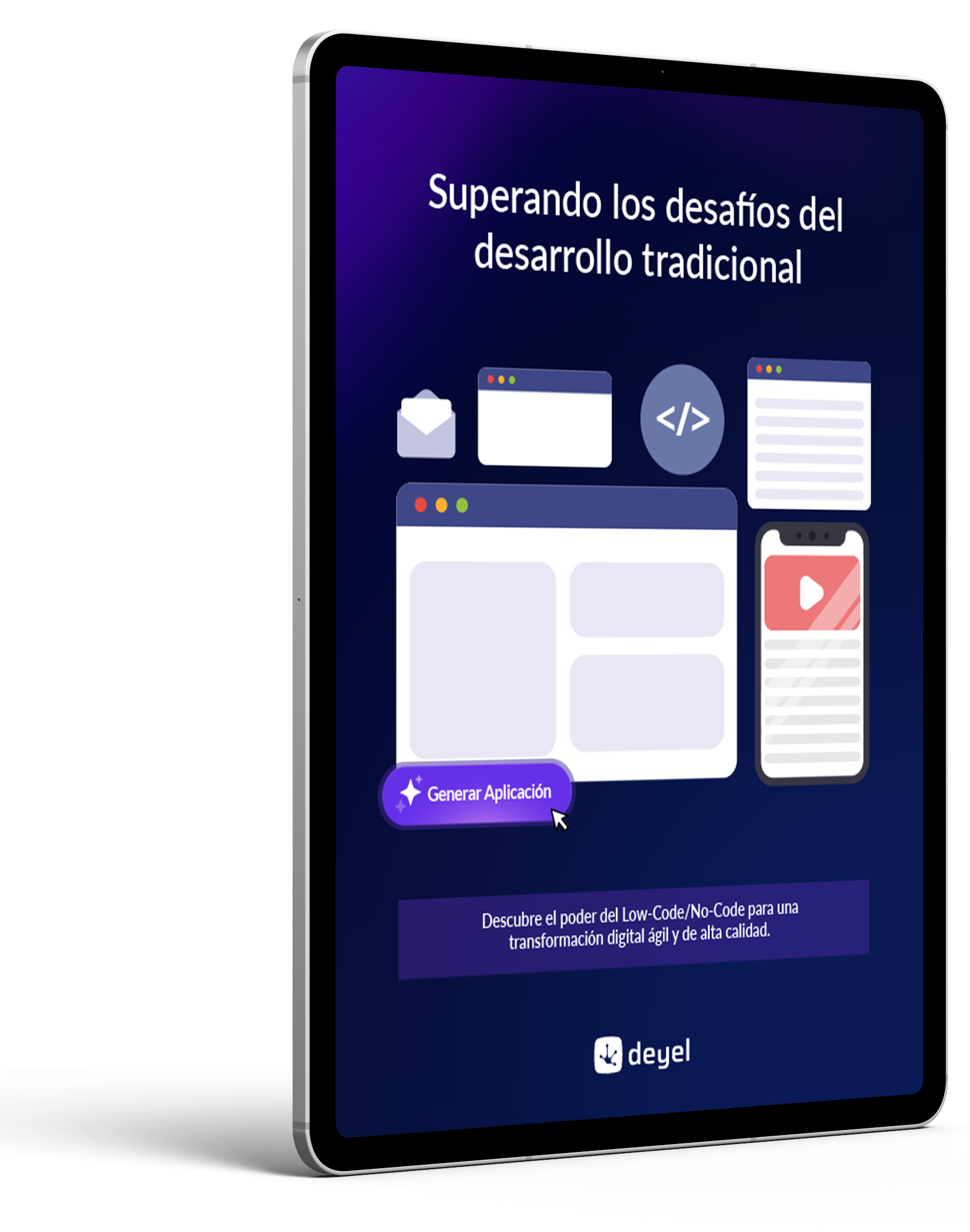
Software for Purchasing and Supplier Management: how to optimize the entire cycle?
July 29, 2025
The Importance of the Core System: Integration for IT and Business
July 29, 2025Low Code + Strategic Collaboration in IT Development Teams

In a business environment that demands agility, adaptability, and constant value delivery, traditional development methods often fall short. The key to survival and success lies in continuous and highly collaborative development.

The Key to Continuous Development in IT
Successful organizations adopt a continuous development approach, where value delivery is iterative, constant, and aligned with the changing needs of the business.
What does continuous development mean for IT?
Continuous development refers to the IT team’s ability to:
- Deliver value regularly: Small and frequent software releases instead of large, spaced-out updates.
- Adapt quickly: Respond to market changes, user feedback, and new business opportunities.
- Automate processes: Implement continuous integration and continuous delivery (CI/CD) practices to reduce errors and accelerate the development lifecycle.
- Maintain quality: Ensure applications remain stable, secure, and scalable in every iteration.
IT Challenges in Traditional Development
- Bottlenecks: Long development cycles.
- Misalignment between business and IT: Delays in delivery that fail to meet urgent business needs.
- Lack of resources: Shortage of experienced developers.
- Technical debt: Accumulation of quick, suboptimal solutions that hinder maintenance.
- Rigidity: Difficulty incorporating changes and feedback once development is underway.

You Should Be Building Apps with Low Code
Overcome the challenges of traditional development with Low Code. Discover how organizations create efficient applications in less time.
Download Practical GuideLow Code as a Key Enabler for Speed and Flexibility
Low Code platforms are redefining how software is built, giving IT a powerful tool to overcome the challenges of traditional development and accelerate value delivery.
What does Low Code development mean for IT?
For IT, Low Code is not simply "less code", but a strategy to:
- Abstract complexity: Enables developers to focus on business logic instead of infrastructure or boilerplate.
- Reusable Components: Provides a catalog of pre-built, functional modules that can be assembled quickly.
- Automation of repetitive tasks: Reduces manual effort in configuration, deployment, and testing.
- Model-driven visual development: Enhances system understanding and collaboration across different roles.
Benefits of Low Code for the IT department
- Increased productivity: Developers can build applications significantly faster.
- Reduced application backlog: Allows IT to handle more business requests in less time.
- Resource optimization: Frees up senior developers for more complex and strategic projects.
- Standardization and governance: Low Code platforms often enforce standards that improve maintainability and security.
- Facilitates adoption of new technologies: Many Low Code platforms integrate APIs and connectors for emerging technologies (AI, IoT, Big Data).
Collaboration as a Cornerstone of Modern Development
True agility and efficiency are achieved when software development becomes a collaborative effort that breaks down departmental silos.
Types of Collaboration in IT Development
-
- Internal IT Collaboration
- Developers: Sharing components, best practices, and code reviews.
- QA/Testing: Early and continuous integration in the development cycle.
- Operations (DevOps): Breaking down barriers for smooth deployment and monitoring.
- Architects: Ensuring consistency and scalability of solutions. - Collaboration Between IT and Business
- Citizen Development: Empowering business users to build their own applications under IT supervision and governance.
- Co-creation: Multidisciplinary teams (IT + Business) working together from conception to deployment.
- Rapid Prototyping: Using Low Code to create functional prototypes that the business can quickly validate.
- Internal IT Collaboration
Tools and Methodologies that Foster Collaboration
- Low Code platforms with collaborative features: Version control, roles and permissions, live comments, shared development environments.
- Agile methodologies (Scrum, Kanban): Encourage constant communication and iterative delivery.
- Integrated communication tools: WhatsApp + the chosen platform’s internal chat.
- Component repositories: Internal libraries of reusable assets.
The Perfect Synergy: Collaboration + Low Code for IT
The combination of Low Code and a collaborative approach not only accelerates development but also transforms the role of IT, making it more strategic and enabling. Rather than being just an executor, IT becomes the center of excellence for Low Code development platforms, playing key roles such as:
- Governance and standards: Setting guidelines for security, performance, quality, and deployment of Low Code applications.
- Platform selection and management: Evaluating, selecting, and managing the appropriate Low Code tools.
- Training and mentoring: Educating IT developers and citizen developers on using the platforms.
- Creation of reusable components: Developing and maintaining libraries of complex modules for the business to use through Low Code.
- Legacy system integration: Connecting Low Code applications to existing core systems.
- Security: Ensuring Low Code applications comply with the company’s security policies.
Low Code as a Catalyst for Multi-Role Collaboration
- Collaborative design: Designers, business analysts, and IT developers can work together visually on the application's interface and workflows.
- Real-time prototyping: The business can view and test functional versions almost immediately, providing valuable feedback.
- Controlled Citizen Development: IT provides the foundation and oversight, while business users build specific solutions for their needs.
- Joint Problem Solving: The visual transparency of Low Code makes it easier for all stakeholders to identify and solve problems together.
Quantifiable Benefits for the IT Department
- Greater Internal Customer Satisfaction: Faster delivery of applications that solve business problems.
- Risk Reduction: Fewer errors thanks to automation and proven components.
- Increased Organizational Agility: The company’s ability to respond to market changes.
- Improved Talent Retention: IT developers can focus on more challenging and strategic tasks.
- Reduction of Technical Debt: Development of more robust and maintainable solutions.
Collaborative Development Model with Low Code in IT
The transition to a collaborative development model powered by Low Code requires a clear strategy and a cultural shift.
Strategic Steps for IT
Challenges to Consider (and How IT Overcomes Them)
- Resistance to change: Educate stakeholders about the value of the Low Code and collaborative approach.
- Shadow IT: Establish a CoE and clear governance to guide citizen developer initiatives.
- Security: Implement robust policies and use platforms with built-in security features.
- Integration with Legacy Systems: Strategically plan integrations and APIs.
- Long-term maintenance: Design for maintainability and establish application lifecycle processes.
Conclusion: IT as the Enabler of the Future
Continuous and collaborative development, powered by Low Code platforms, is not a passing trend—it's the path to a future where the IT department is more agile, strategic, and responsive. By embracing this mindset and these tools, IT can shift from being a service provider to a true business partner, leading digital transformation and shaping the organization’s future.
The collaboration and speed that define the Low Code approach are essential for growth in today’s market. The fusion of both concepts creates a development ecosystem where innovation flourishes, bottlenecks disappear, and value delivery becomes part of the company’s daily routine.
It’s time for your IT department to lead the charge in the era of continuous development! Schedule a consultation with our Low Code experts.

